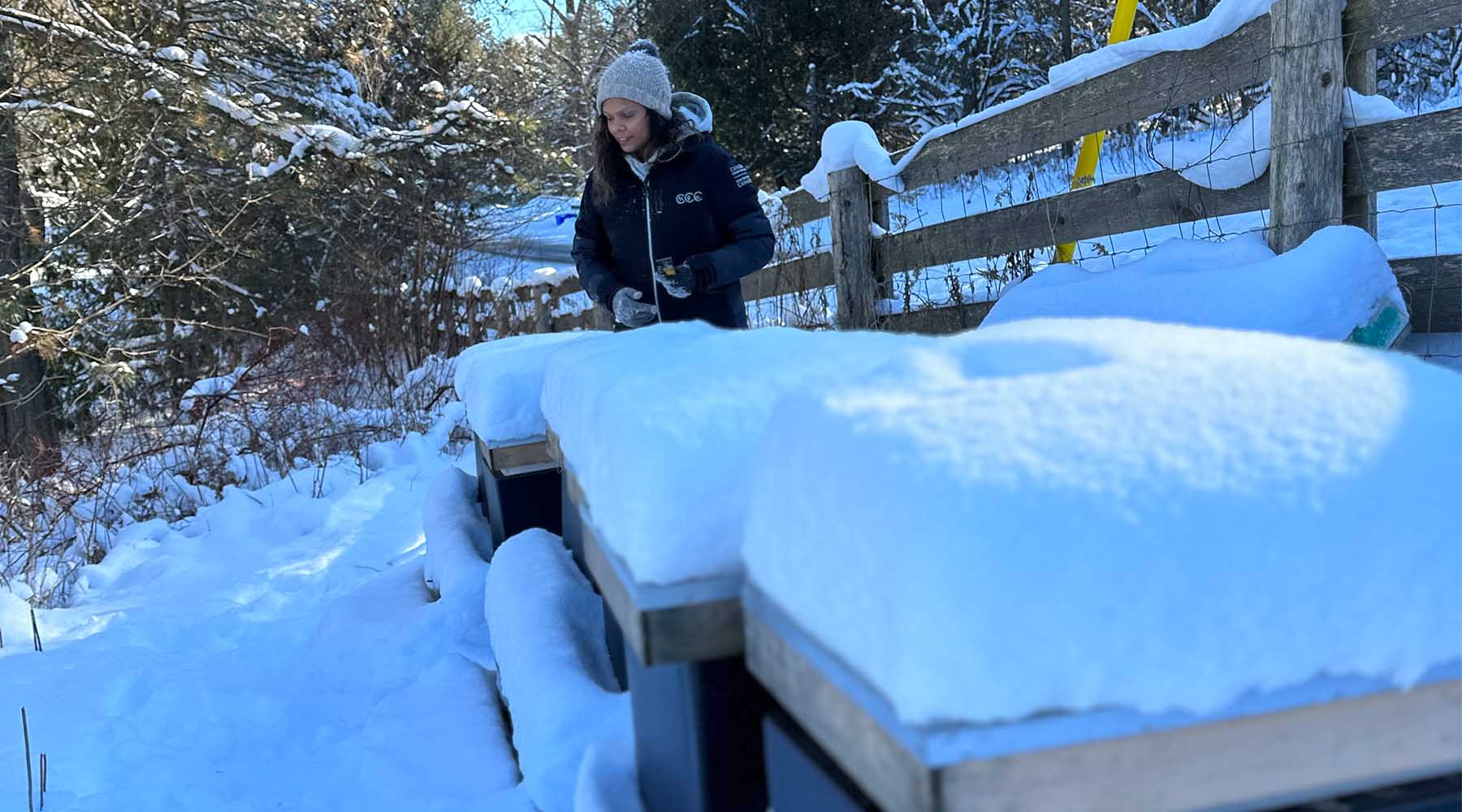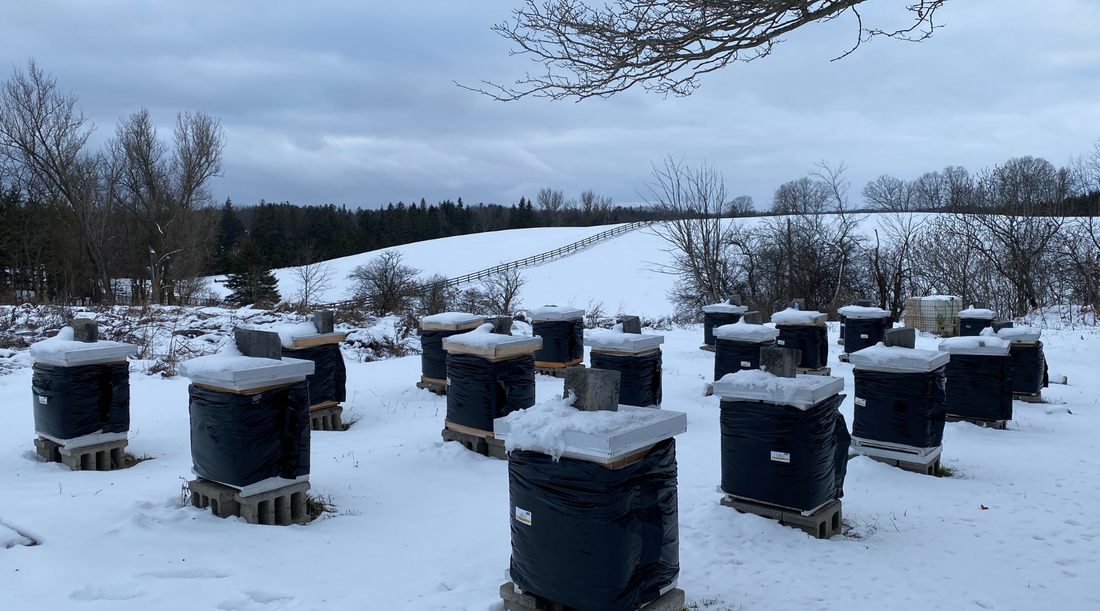The sound of buzzing bees is as much a part of spring and summer as sunshine and flowers. As the temperature cools and the days shorten, the seasonal shift coincides with a decline in the bees’ activity levels. But unlike some of their mammalian neighbours, bees aren’t holed up inside their hives, sleeping the cold away. Instead of hibernating, what the bees are doing is a little more complex.
Do bees hibernate?
Bees cannot function properly below approximately 12°C, so it seems logical that hibernation would carry them through the coldest, darkest months of winter. However, it doesn’t. During true hibernation, an animal lowers its metabolic output and goes to sleep for the entire winter. Their respiration rate and even their heartbeat slow significantly, and their body feeds off the stores of fat they’ve accumulated during the summer and fall.
Diapause, which is characterized by a reduced metabolic rate, is the term scientists use to describe this phenomenon in insects. And, because honey bees do reduce their physiological processes as the temperature drops, they do enter a form of diapause. However, they don’t go to sleep.
Bees curtail all their movements and stop leaving the hive until the weather warms up. But, while many insects spend this time in suspended animation, honey bees stay awake and continue with certain key behaviours — most notably, keeping themselves warm.
How do bees stay warm in winter?
A beehive in winter is a lot like a three-season cabin or shed without indoor heating: woefully inadequate for the weather. So what do bees do when it’s well below zero and installing a furnace isn’t an option? The good news is that bees are heterothermic. This means they’re both exothermic and can pull heat from external sources and endothermic, meaning they can also generate their own heat.
Since exothermic heat sources like the sun aren't sufficient to keep the colony warm during the winter, the bees have to switch to endothermic sources and generate their own heat. In order to do this, they mass together and vibrate their wing muscles, essentially shivering to keep toasty. As socially-minded individuals, each bee takes its turn spending time in both the warmer inner and the cooler outer layers of the cluster. The one exception is the hive’s queen. She spends much of her time at the centre of the mass where she can maintain a consistently comfortable body temperature.
Despite the heat they’re able to generate, the bees’ ideal temperature range of 33-36°C becomes all but impossible to sustain without external heat sources. Instead, their muscle work keeps the hive hovering somewhere between 15-30°C. While this isn’t high enough to support the environment they need for brood rearing, it keeps the queen healthy and prevents the bees from freezing to death.
Most Canadian beekeepers (and others who live in cold winter countries) also elect to help their bees by winterizing their hives. Here at Kinghaven Farms, after the pollen patties, sugar water, and mite treatments are all done we wrap our hives in a “bee cozy”.
It’s not quite what you would use to cover your tea pot, but the principle of a bee cozy is the same. These covers typically consist of a polypropylene sleeve filled with fiberglass that acts as an insulating cover over the hive. These insulated cozies mean that any cracks are sealed and the bees are wrapped in an additional layer of warmth, ensuring they’re protected from the worst of winter’s wrath.

What do bees eat during the winter?
Honey is a superfood, highly nutritious and great for boosting energy. To that end, bees make it throughout the spring and summer as part of their diet (in addition to pollen and nectar).
Come winter, honey shifts from being part of the bees’ diet to being essential to their survival. Due to its antimicrobial and antibacterial properties, honey doesn’t spoil. This allows the bees to stockpile it in their hive and live off it all winter long.
Does taking honey from a hive compromise its ability to get through winter?
It is possible to take too much honey from a hive. However, bee colonies often produce more honey than they need for the coldest months as a form of insurance. This overabundance is also fortuitous for humans as it allows beekeepers to harvest honey while ensuring the bees have enough to make it through the winter.
Responsible beekeepers often supplement their bees’ diets with pollen patties or sugar syrup in the fall and sugar cakes in the winter. This guarantees that the colony will have the calories it needs to keep the bees fed and generating their energy-intensive heat. It’s also common practice for years where the bees are unable to produce as much honey as they need. And, it gives them a quick and easy form of energy to access until the weather warms and the first flowers emerge.
How does the composition of the bees in the hive change during winter?
A hive in winter is much quieter than its summer counterpart. In summer, worker bees inhabit a multitude of roles while a horde of drones hangs about, hoping for an opportunity to mate with a neighbouring hive’s queen. Come winter, resources become scarcer and fewer eggs are laid, resulting in a smaller number of worker bees and a complete lack of drones. Because of this, an active colony can go from as many as 80,000 bees at its peak, to fewer than 20,000 during the winter.
What are winter bees?
Saying a honey bee has a large fat body might sound unscientific, but it’s actually a key feature of bees that are born in the cooler months. The term “fat body” isn’t a way of describing what these so-called “winter bees" look like. Instead, the fat body is an organ that enables insects to store fat and glycogen. These two substances serve as reserves of energy that the insect can call upon when sources of it are harder to come by.
The fat body also makes vitellogenin, a protein and a precursor for egg yolk. Worker bees use this protein to produce royal jelly which they feed to bee larvae during their first days and the queen bee for her entire life. If you’ve heard of royal jelly before, it’s likely because of the enviable benefits it imparts to the queen. Not only does this all-royal jelly diet make her fertile, but it also helps her live exponentially longer than her worker bee sisters — an average of one to two years.
Without any brood to make royal jelly for during the cooler months, worker bees are able to store up vitellogenin. And it seems that this act of stockpiling the protein may play a part in extending their lives. Winter bees live somewhere between 150-200 days. In contrast, their sisters who hatch during the warmer months of the year live an average of 15-38 days.
Does the hive get dirty during the winter?
Bees can’t fly properly once the temperature drops to about 54°F or 12°C. Below this temperature, they lose neuromuscular function, preventing them from controlling their movements. As a result, bees don't leave the nest on cooler days. Instead, they stay cooped up for weeks and even months during the fall and winter.
While the bees are able to keep warm inside the hive, curtailing their movements poses some unique challenges waste-wise. During the spring, foraging bees poop outside the hive, usually mid-flight. The rest of the population typically defecates inside, tasking a number of worker bees with clearing it out.
However, the colder months stop everyone from leaving the hive — even to take out the waste. You might expect that this means that poop piles up inside the hive, but the opposite is true. Instead, being unable to go outside the hive in winter means that the bees simply stop pooping. While this sounds intensely uncomfortable, it’s a highly adaptive behaviour, minimizing the spread of viruses and unsanitary conditions within the hive.
In a bid to keep their home clean, honey bees will refrain from defecating for weeks and even months during the winter. In fact, they’ll continue to hold their poop until they can take a “cleansing flight.” Unfortunately, these cleansing flights aren’t based on need, but instead on temperature. In other words, the colony must wait for a day that’s warm enough before they can leave the hive en masse to empty themselves out.
When do the bees become active again?
Bees are stenothermal, meaning they can only survive within a limited temperature range. Throughout their developmental phases, from the egg stage to the larval and pupal periods, bees function best between 33-36°C. Spending too long below 32°C can result in abnormalities, and pupae that spend too long below this threshold are more likely to have developmental malformations as well as behavioural and neural issues.
Because they’re so dependent on specific temperatures, honey bees don’t become active until spring. While they’ll take cleansing flights once the weather permits, they’re unable to forage until it’s consistently warm. The timing of this varies across the country, but it typically means that they await the emergence of the first blooms — usually daffodils and crocus around the end of March or the beginning of April. At this point, the beekeepers joyously remove the hive cozies, begin spring hive inspections, and dust off their gear for another season.
Once the temperature is dependably warmer and nectar and pollen are reliably available, the bees begin to build up food stores and the queen embarks on an egg-laying spree. Under these conditions, she quickly builds momentum and can lay between 1,500-2,000 eggs a day during the warmest months. This helps the colony’s population swell which is crucial for both the bees’ survival and for producing everyone’s favourite superfood: honey.
